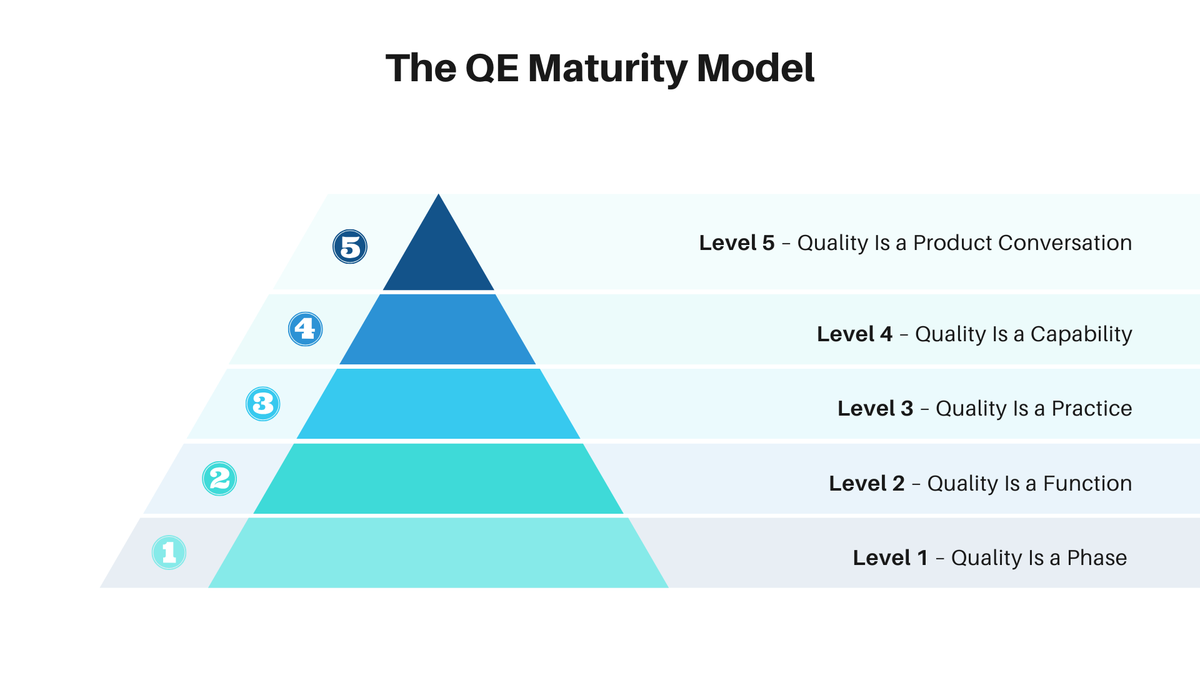Evolving the QE Maturity Model: Quality Beyond Testing

This is the post that launched Break the Build.
It’s for every engineer, tester, or leader who's felt the pain of broken QA processes; and wants something better. I’ve spent 15+ years in the trenches of testing and automation, and this is the truth I wish someone had handed me years ago.
Level 1 – Quality Is a Phase
- Testing: Manual testing dominates and happens at the end of the sprint or even post-release. Regression takes days (or weeks).
- Culture: QA is treated as a safety net rather than a partner. Engineers "throw it over the wall" and move on.
- Org Design: QA is a separate team, often under-resourced and reactive.
- Metrics: Limited to bug counts and pass/fail test cases—none of which reflect true quality.
- Tooling: Local scripts, Excel test cases, and no CI integration.
💡 The pain here is high: late bugs, blame games, and missed deadlines.
Level 2 – Quality Is a Function
- Testing: Automation begins, but it’s UI-heavy and fragile. Coverage is partial and mostly regression-focused.
- Culture: Testing is acknowledged but often rushed. QAs still get pulled in after dev is “done.”
- Org Design: Automation engineers appear, but they’re still siloed from development teams.
- Metrics: Coverage is tracked—often manually—but quality signals are shallow.
- Tooling: Some tests run in CI, but they’re unreliable and slow.
💡 You’ve taken a step forward, but technical debt starts to mount.
Level 3 – Quality Is a Practice
- Testing: Test cases are mapped to requirements. Pipelines stabilize. Coverage includes API, component, and integration layers.
- Culture: Shift-left begins. Engineers and QEs talk early and often.
- Org Design: QEs are embedded in product teams. Test planning happens during grooming and design.
- Metrics: Flakiness rates, test debt, and traceability begin to surface in conversations.
- Tooling: CI/CD improves. Performance, accessibility, and security testing are incorporated earlier.
💡 This is the tipping point—teams now prevent bugs instead of chasing them.
Level 4 – Quality Is a Capability
- Testing: Tests are modular, resilient, and data-driven. Synthetic test data, test doubles, and mocks are commonly used.
- Culture: Developers and QEs co-own outcomes. Code reviews include test design.
- Org Design: Platform QE roles emerge, enabling tools, practices, and frameworks at scale.
- Metrics: MTTR, defect escape rate, lead time, deployment frequency—all are visible and improving.
- Tooling: Dashboards, observability, test analytics, and feedback loops are integrated into the pipeline.
💡 Quality is no longer one person’s job—it’s a shared capability that unlocks velocity.
Level 5 – Quality Is a Product Conversation
- Testing: Intelligent, risk-based testing powered by GenAI and self-healing capabilities. Test strategy adapts to product and business priorities.
- Culture: Everyone—from PM to dev to QE—thinks about quality early and often. It’s embedded into product discovery and experimentation.
- Org Design: QE dissolves as a "team" and re-emerges as a competency across engineering.
- Metrics: Quality KPIs (like user satisfaction, NPS, churn) are tied directly to engineering initiatives.
- Tooling: Autonomous agents assist with test generation, triage, and release readiness—making quality faster and smarter.
💡 At this level, quality is not just built in. It’s a strategic advantage.
Final Thought
Quality Engineering isn’t just a testing strategy; it’s an engineering culture. The most mature organizations don’t just test better; they build better.
Where do you see your team on this spectrum?
What would it take to level up?
👉 Want more posts like this? Subscribe and get the next one straight to your inbox. Subscribe to the Blog or Follow me on LinkedIn



Comments ()